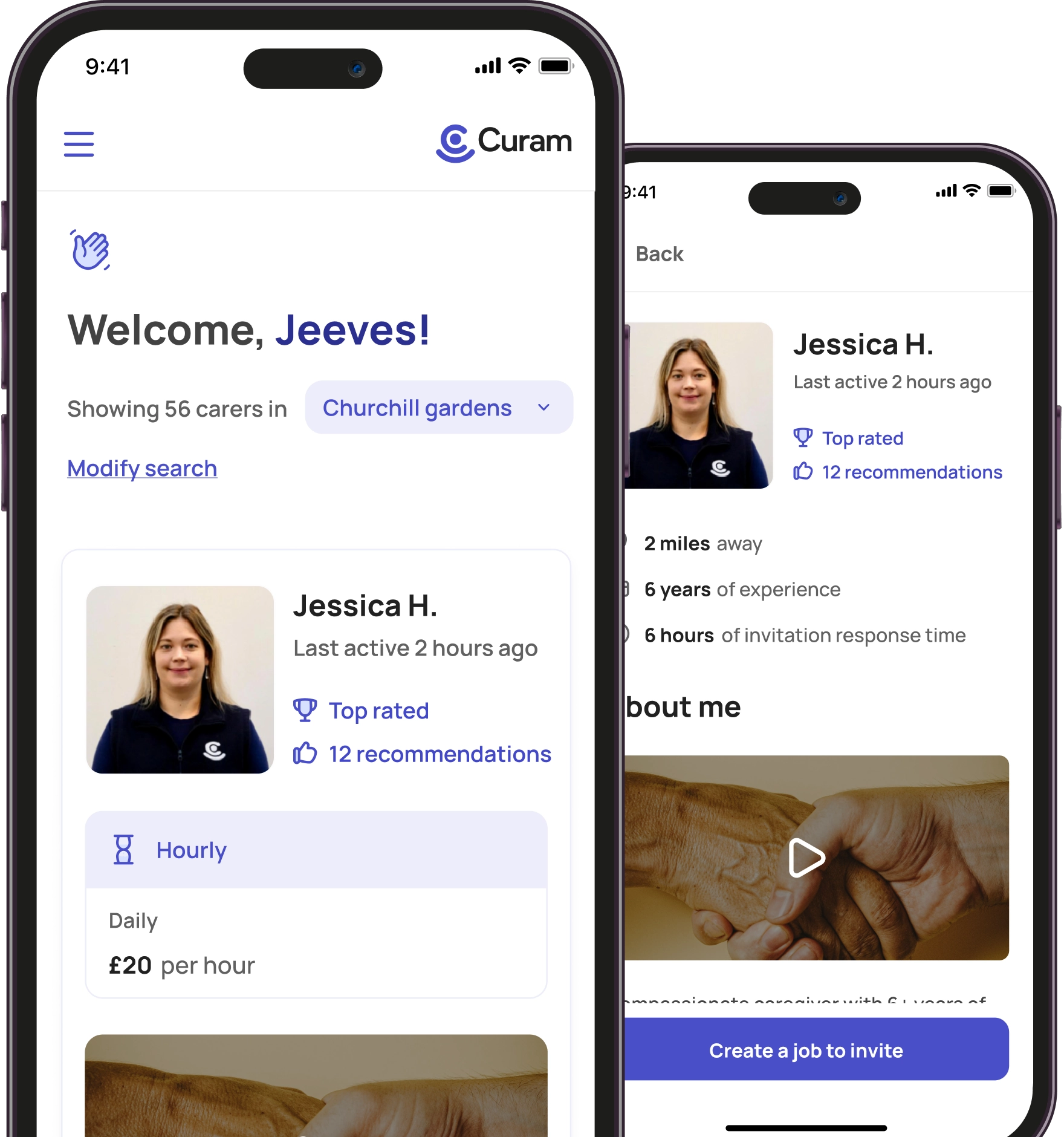Curam Team
March 13, 2024

Living with any condition that can be managed or supported with medication can ensure a person can enjoy wellbeing and independence away from the intensity of a medical setting.
However, keeping on top of taking regular doses of medication can sometimes feel challenging, especially if you're living with a chronic condition. Around 15% of people in England take five or more prescription drugs every day and according to Age UK almost two million people in the UK over 65 are likely to be taking at least seven prescribed medicines.
Thankfully there's lots of tools you can use to support you to ensure you're effectively managing your medication.
What is a dosette box?
A dosette box, also known as a pill organiser or pill box, is a container with clearly labelled compartments designed to help individuals organise and manage their medication intake.
These boxes typically have separate compartments for each day of the week or each time of day, allowing users to pre-sort and store their pills for easy access.
How to use a dosette box
Using a dosette box is a straightforward process, and it can greatly assist in organising and managing medications. Here's a step-by-step guide on how to use a dosette box:
Select a Suitable Dosette Box
Choose a dosette box that meets your needs. They come in various designs, with compartments for each day of the week and sometimes further divided by time of day.
Gather Medications and Schedule
Collect all the medications you need to take during the week.
Have a clear understanding of your medication schedule, including the specific doses and times.
Organise Medications
Begin by organising your medications for the entire week. Take note of any special instructions regarding the timing or conditions for taking each medication.
Open the Dosette Box
Open the dosette box and ensure it is clean and dry.
Fill Each Compartment
Starting with the first day, fill each compartment with the prescribed medications for that day and time. Some dosette boxes have separate sections for morning, afternoon, evening, and night.
Be Accurate
Pay close attention to the accuracy of the medications you place in each compartment. Verify that you are placing the correct medication in the designated slot.
Close the Dosette Box
Once you have filled all the compartments for the week, securely close the dosette box. Make sure it is properly sealed to prevent any accidental spillage or mixing of medications.
Store in a Safe Place
Store the dosette box in a safe and easily accessible place. This could be on a countertop, bedside table, or any location where you will remember to take your medications.
Take Medications as Directed
Each day, open the dosette box for the corresponding day and time and take the medications as directed by your healthcare provider.
Refill Weekly
Set a regular time each week to refill the dosette box for the upcoming week. This ensures that you are always organised and prepared.
Monitor and Adjust
Regularly monitor your dosette box to ensure that you are taking your medications as prescribed. If there are any changes to your medication regimen, adjust the dosette box accordingly.
What are the benefits of using a dosette box?
Organisation
Dosette boxes help users organise their medications, making it easier to keep track of which pills need to be taken at specific times.
Medication Adherence
They can improve medication adherence by reducing the chances of missing doses. When pills are pre-sorted for each day or time, it becomes simpler to remember and manage the medication schedule.
Convenience
Dosette boxes are convenient for people who take multiple medications. Instead of managing several pill bottles, they can use a single box with compartments for each medication.
Travel-Friendly
For people who need to take medication on the go, dosette boxes are portable and can be easily carried in a purse or bag. This is especially helpful for individuals who travel frequently.
Safety
Dosette boxes and pill organisers can enhance a person's safety by reducing the risk of medication errors. When pills are pre-sorted, it's less likely that someone will accidentally take the wrong medication, miss or accidentally repeat a dose.
How can you get a dosette box?
Do you qualify for a dosette box?
Under the 2010 Equality Act, if you find taking medication challenging, a community pharmacy service has to provide solutions including dosette boxes, to help you.
Also if someone has a complicated medicine regime with different pills taken at various times of the day, a pharmacist may provide a dosette box however this is never guaranteed and completely depends on an individual's circumstances.
For example, Buckden Pharmacy in Saint Neots offer dosette boxes as an additional service to patients who need them which is both free of charge to the NHS and to the patient. As with all NHS prescription medication, they'll deliver them to the person's home or nominated address free of charge.
Simple Online Pharmacy
If you receive at least four different medications, Simple Online Pharmacy will provide you with a free dosette box.
All you need to do is register and provide the details of your GP. Once you’ve done this, just let them know which medication you require, and this will be ordered on your behalf. and sent to you in easy-to-open pouches.
This whole process - from registration to delivery - usually takes around 48-72 hours.
Buying a dosette box
You can find a vast array of reasonably priced dosette boxes to purchase sites like Amazon, Ebay starting from around £4. You can also find them in pharmacies and some high street stores like Argos.
How can a live-in carer help manage medication?
Dosette boxes are useful for caregivers who may be responsible for managing medications for someone else. They provide an easy and organised way to ensure that the right medications are taken at the right times.
For many elderly individuals, managing medications independently can be challenging. Some may struggle with memory, especially if living with dementia, leading to missed doses. Others might face difficulty taking medications at the correct times. Additionally, for those living alone, accessing the pharmacy can be a logistical challenge. Managing multiple medications can be confusing, and reduced mobility and independence further impact one's ability to handle medications effectively.
A carer can effectively use a dosette box to assist in managing a person's medications by following these steps:
Understanding the Medication Schedule
Becoming familiar with the client's prescribed medications, doses, and the recommended schedule for taking each medication.
Organising Medication
Arrange the medications for each day and time according to the prescribed schedule.
Selecting the Appropriate Dosette Box
Choose a dosette box that accommodates the number of medications and doses required for the individual.
Filling the Dosette Box
Fill each compartment of the dosette box with the corresponding medication for the designated day and time.
Ensure accuracy by cross-referencing the dosages with the prescription information.
Labelling the Dosette Box
Clearly label the dosette box with the day and time for each compartment to avoid confusion.
Communicating with the Person Receiving Care
Inform the individual about the dosette box system and explain how it works.
Emphasise the importance of taking medications as prescribed.
Regularly Updating the Dosette Box
Periodically review the medication schedule to accommodate any changes made by healthcare professionals.
Refill the dosette box accordingly, ensuring it remains up-to-date.
Monitoring Medication Adherence
Keep track of whether the individual is consistently taking medications from the dosette box.
Communicate any concerns or issues with the person's healthcare team.
Ensuring Accessibility
Place the dosette box in a convenient and easily accessible location for the person receiving care.
Seeking Professional Guidance
If there are uncertainties or challenges, consult with healthcare professionals, such as pharmacists or doctors, for guidance on medication management.
By following these steps, a carer can use a dosette box as an effective tool to organise and administer medications, promoting adherence and enhancing the overall management of a person's healthcare routine.
It's important to note that while dosette boxes can be beneficial, they may not be suitable for all types of medications. Always consult with a healthcare professional or pharmacist to ensure that the chosen organisation method aligns with the specific requirements of the prescribed medications.
Dosette boxes vs blister packs
A dosette box and a blister pack are both used for medication management, but they have distinct characteristics that may make one more suitable than the other depending on individual needs and preferences. Here are some factors to consider:
Customisation
Dosette Box: It allows for more flexibility in terms of medication customisation. Users can manually fill the compartments with specific pills and adjust the dosage as needed.
Blister Pack: Typically pre-packaged by a pharmacist or manufacturer, providing a standardised and fixed dosage for each day or time.
Portability
Dosette Box: It may be bulkier and less portable due to its larger size and the need for manual filling.
Blister Pack: Compact and individually sealed, making it more portable and convenient, especially for people who are frequently on the move.
Ease of Use
Dosette Box: Users need to manually fill the compartments, which can be time-consuming and may require good manual dexterity.
Blister Pack: Easy to use and often preferred for individuals with visual or cognitive impairments, as the days and times are clearly marked.
Visual Monitoring
Dosette Box: Provides a clear visual representation of whether a dose has been taken or missed, as users can see the contents of each compartment.
Blister Pack: The sealed blisters provide a visual cue, but it may not be as immediate or obvious as a dosette box.
Flexibility in Medication Changes
Dosette Box: Allows for easy adjustments to medication regimens without requiring new packaging.
Blister Pack: Changes to medications may necessitate new blister packs, which can be an inconvenience.
Cost
Dosette Box: Generally, a one-time purchase with no ongoing costs.
Blister Pack: May involve ongoing costs as each set of blister packs needs to be prepared by a pharmacist.
Ultimately, the choice between a dosette box and a blister pack depends on the individual's specific needs, preferences, and the nature of their medication regimen. Some people may find the simplicity and convenience of a blister pack more suitable, while others may prefer the flexibility and visibility provided by a dosette box.
What are the alternatives to using a dosette box?
There are various methods beyond using a dosette box to help manage medication. Here are some additional ways to manage medication effectively:
Medication Reminder Apps
Use smartphone apps designed to send reminders for medication doses. These apps often allow you to set custom schedules, track medications, and receive notifications.
Alarms and Timers
Set alarms or timers on your phone or other electronic devices to remind you when it's time to take your medication.
Pill Dispensers with Alarms
Invest in electronic pill dispensers that not only store your medication but also have built-in alarms to remind you when to take each dose.
Calendar Reminders
Mark your medication schedule on a physical or digital calendar to help you stay organised and remember your doses.
Medication Management Services
Consider using medication management services, which may include medication synchronisation, blister packaging, and home delivery.
Family or Caregiver Assistance
Enlist the help of a family member, friend, or caregiver to remind you about your medication schedule.
Medication Journal
Keep a medication journal to record when you take each dose. This can help you track your adherence and share information with healthcare providers.
Smart Pill Bottles
Some pill bottles come with smart technology that can send reminders to your phone or alert a caregiver if a dose is missed.
Routine Integration
Associate taking medication with daily routines, such as meals or bedtime, to create a habit.
Medication Therapy Management (MTM)
Work with healthcare professionals, such as pharmacists, who specialise in MTM to optimise your medication regimen and address any concerns or questions you may have.
Always consult with your healthcare provider or pharmacist before making any changes to your medication management routine. They can provide personalised advice based on your specific health needs.
Further useful resources all about dosette boxes and medication management
Medicine tips for carers - NHS
Adaptations and equipment to make home tasks easier
Alzheimer’s Association – medication management and dementia
Parkinson’s UK – Q&A about medication management for those with Parkinson’s






 Vetted & approved carers
Vetted & approved carers
 DBS checked & insured
DBS checked & insured
 Back
Back







